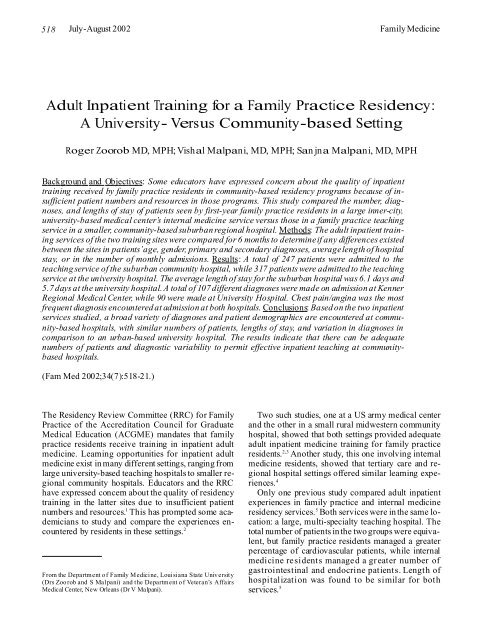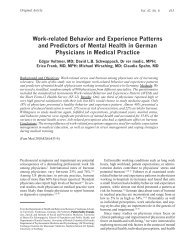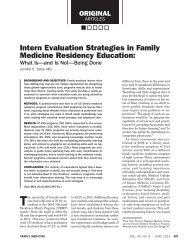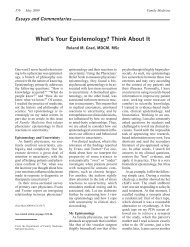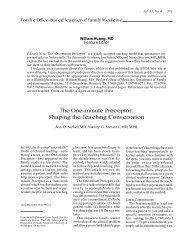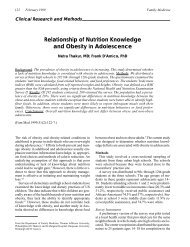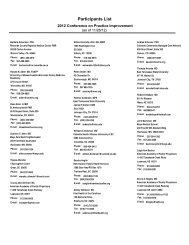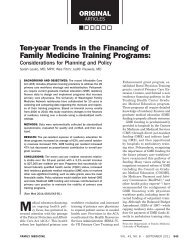Adult Inpatient Training for a Family Practice Residency: A ... - STFM
Adult Inpatient Training for a Family Practice Residency: A ... - STFM
Adult Inpatient Training for a Family Practice Residency: A ... - STFM
You also want an ePaper? Increase the reach of your titles
YUMPU automatically turns print PDFs into web optimized ePapers that Google loves.
518 July-August 2002 <strong>Family</strong> Medicine<br />
<strong>Adult</strong> <strong>Inpatient</strong> <strong>Training</strong> <strong>for</strong> a <strong>Family</strong> <strong>Practice</strong> <strong>Residency</strong>:<br />
A University- Versus Community-based Setting<br />
Roger Zoorob MD, MPH; Vishal Malpani, MD, MPH; San jna Malpani, MD, MPH<br />
Background and Objectives: Some educators have expressed concern about the quality of inpatient<br />
training received by family practice residents in community-based residency programs because of insufficient<br />
patient numbers and resources in those programs. This study compared the number, diagnoses,<br />
and lengths of stay of patients seen by first-year family practice residents in a large inner-city,<br />
university-based medical center’s internal medicine service versus those in a family practice teaching<br />
service in a smaller, community-based suburban regional hospital. Methods: The adult inpatient training<br />
services of the two training sites were compared <strong>for</strong> 6 months to determine if any differences existed<br />
between the sites in patients’ age, gender, primary and secondary diagnoses, average length of hospital<br />
stay, or in the number of monthly admissions. Results: A total of 247 patients were admitted to the<br />
teaching service of the suburban community hospital, while 317 patients were admitted to the teaching<br />
service at the university hospital. The average length of stay <strong>for</strong> the suburban hospital was 6.1 days and<br />
5.7 days at the university hospital. A total of 107 different diagnoses were made on admission at Kenner<br />
Regional Medical Center, while 90 were made at University Hospital. Chest pain/angina was the most<br />
frequent diagnosis encountered at admission at both hospitals. Conclusions: Based on the two inpatient<br />
services studied, a broad variety of diagnoses and patient demographics are encountered at community-based<br />
hospitals, with similar numbers of patients, lengths of stay, and variation in diagnoses in<br />
comparison to an urban-based university hospital. The results indicate that there can be adequate<br />
numbers of patients and diagnostic variability to permit effective inpatient teaching at communitybased<br />
hospitals.<br />
(Fam Med 2002;34(7):518-21.)<br />
The <strong>Residency</strong> Review Committee (RRC) <strong>for</strong> <strong>Family</strong><br />
<strong>Practice</strong> of the Accreditation Council <strong>for</strong> Graduate<br />
Medical Education (ACGME) mandates that family<br />
practice residents receive training in inpatient adult<br />
medicine. Learning opportunities <strong>for</strong> inpatient adult<br />
medicine exist in many different settings, ranging from<br />
large university-based teaching hospitals to smaller regional<br />
community hospitals. Educators and the RRC<br />
have expressed concern about the quality of residency<br />
training in the latter sites due to insufficient patient<br />
numbers and resources. 1 This has prompted some academicians<br />
to study and compare the experiences encountered<br />
by residents in these settings. 2<br />
From the Department of <strong>Family</strong> Medicine, Louisiana State University<br />
(Drs Zoorob and S Malpani) and the Department of Veteran’s Affairs<br />
Medical Center, New Orleans (Dr V Malpani).<br />
Two such studies, one at a US army medical center<br />
and the other in a small rural midwestern community<br />
hospital, showed that both settings provided adequate<br />
adult inpatient medicine training <strong>for</strong> family practice<br />
residents. 2,3 Another study, this one involving internal<br />
medicine residents, showed that tertiary care and regional<br />
hospital settings offered similar learning experiences.<br />
4<br />
Only one previous study compared adult inpatient<br />
experiences in family practice and internal medicine<br />
residency services. 5 Both services were in the same location:<br />
a large, multi-specialty teaching hospital. The<br />
total number of patients in the two groups were equivalent,<br />
but family practice residents managed a greater<br />
percentage of cardiovascular patients, while internal<br />
medicine residents managed a greater number of<br />
gastrointestinal and endocrine patients. Length of<br />
hospitalization was found to be similar <strong>for</strong> both<br />
services. 5
Award-winning Papers From the AAFP 2001 Annual Scientific Assembly<br />
To our knowledge, however, there are no studies comparing<br />
the inpatient medicine training experiences of<br />
the same family practice residency in two different settings.<br />
Our current study compares first-year family practice<br />
residents’ inpatient experiences in a large urban<br />
university-based teaching hospital to their experiences<br />
in a small suburban community hospital. Our main<br />
objective was to determine if there were differences<br />
between the two settings in patient volume, diagnoses,<br />
and lengths of stay.<br />
Methods<br />
Human Subjects Protection<br />
This research project received exempt approval in<br />
May 2000 from Louisiana State University School of<br />
Medicine, New Orleans.<br />
Setting<br />
Our family practice residency uses two different hospitals<br />
<strong>for</strong> inpatient care. One is University Hospital (UH)<br />
in New Orleans, a 570-bed tertiary care teaching hospital<br />
located in the heart of New Orleans, a metropolitan<br />
city with a population of around 450,000. The other<br />
is Kenner Regional Medical Center (KRMC), a 90-bed<br />
community-based hospital located about 15 miles from<br />
New Orleans in the suburban city of Kenner that borders<br />
several rural counties.<br />
The residency program’s inpatient adult medicine<br />
teaching involves 2 months during the first year of residency.<br />
The first of these months is spent on UH’s internal<br />
medicine inpatient service. This service is staffed<br />
by one attending physician and one senior internal<br />
medicine resident, both of whom supervise three junior<br />
residents, one of whom is a family practice resident.<br />
The second month is spent on the inpatient adult<br />
family practice service at KRMC. This service is staffed<br />
by a family practice attending physician who supervises<br />
one upper-level and two first-year family practice<br />
residents.<br />
Data Collection<br />
Each day, both residency inpatient services routinely<br />
generate a “Patients’ Daily Census” report <strong>for</strong> purposes<br />
of monitoring the educational experience of residents.<br />
Each census <strong>for</strong>m contains patients’ identification numbers,<br />
age, date of admission and discharge, and primary<br />
and secondary diagnoses. The in<strong>for</strong>mation from these<br />
<strong>for</strong>ms was extracted <strong>for</strong> use as data in this study.<br />
Data Analysis<br />
Data were collected during March, May, July, August,<br />
October, and December 2000, <strong>for</strong> a total of 6<br />
months. At the end of 6 months, we computed descriptive<br />
statistics <strong>for</strong> key parameters describing the activity<br />
of the two clinical services. These parameters included<br />
number of monthly admissions, average length of hos-<br />
Vol. 34, No. 7<br />
519<br />
pital stay, patients’ age, and primary and secondary diagnoses.<br />
We then conducted a statistical analysis to<br />
determine if there were significant differences between<br />
the two training sites in any of these parameters. Differences<br />
between means were tested with two-sample<br />
independent t tests, and differences in proportions were<br />
tested with the chi-square statistic. All statistical computations<br />
were made with the SPSS ® <strong>for</strong> Windows.<br />
Results<br />
Number of Patients and Lengths of Stay<br />
The total number of patients seen over the 6-month<br />
study period at KRMC was 247 and at UH was 317.<br />
Each first-year resident was responsible <strong>for</strong> approximately<br />
21 patients per month at KRMC; at UH, each<br />
first-year resident saw approximately 18 patients per<br />
month—this difference was not statistically significant<br />
(P=.11). Significantly more patients were male at UH<br />
than at KRMC (55.2% versus 37.7%, P
520 July-August 2002 <strong>Family</strong> Medicine<br />
Table 1<br />
List of Top 20 Diagnoses at <strong>Adult</strong> <strong>Inpatient</strong><br />
Service at University Hospital<br />
and Kenner Regional Medical Center<br />
University Hospital Kenner Regional Medical Center<br />
Chest pain/angina 45 Chest pain/angina 32<br />
CHF exacerbation 27 Urinary tract infection 11<br />
Pneumonia 25 Acute coronary syndrome 10<br />
Gastrointestinal bleed 13 Pneumonia 9<br />
Cellulitis 13 Dehydration 8<br />
Atrial fibrillation 12 Abdominal pain 7<br />
Asthma exacerbation 11 Cerebrovascular accident 6<br />
Acute mental status changes 10 Diabetic ketoacidosis 6<br />
Syncope 9 Anemia 6<br />
Diabetic ketoacidosis 7 CHF exacerbation 5<br />
Acute coronary syndrome 6 Gastrointestinal bleed 5<br />
Pancreatitis 6 Sickle cell pain crisis 5<br />
Cerebrovascular accident 5 Cellulitis 5<br />
Hypertension 5 COPD exacerbation 5<br />
Dehydration 5 Respiratory failure 5<br />
Crohn’s Disease 4 Diabetes mellitus 4<br />
Sickle cell crisis 4 Hip fracture 4<br />
Alcohol withdrawal 4 Bacterial endocarditis 3<br />
Endocarditis 3 Transient ischemic attack 3<br />
Cirrhosis 3 Acute pancreatitis 3<br />
CHF—congestive heart failure<br />
COPD—chronic obstructive pulmonary disease<br />
Our findings are important because the ACGME<br />
RRC <strong>for</strong> <strong>Family</strong> <strong>Practice</strong> has expressed concern about<br />
the training experience in smaller hospitals. 1 Based on<br />
the results of our study, this concern may be unwarranted.<br />
The results of our study support those of Holten and<br />
David, who reported that family practice residents can<br />
have an adequate inpatient training experience in an<br />
80-bed rural hospital. 2 Our results also confirm the results<br />
of O’Brien et al, who found that the patient problems<br />
encountered by internal medicine residents in the<br />
regional and tertiary care settings were similar. 4<br />
Limitations<br />
This study is limited by the absence of a gold standard<br />
<strong>for</strong> what constitutes optimal inpatient adult medicine<br />
training <strong>for</strong> family practice residents. That is, although<br />
our study demonstrated that residents in the two<br />
settings encountered similar numbers of patients with<br />
a similar mix of diagnoses, we cannot confirm that<br />
teaching and learning in each setting is of similar quality.<br />
Nor can we confirm from our data that the approach<br />
to patient care in the two settings was similar, though<br />
we have no reason to believe it was not.<br />
Another limitation is that our 6-month study only<br />
sampled a few hundred admissions at each site. This<br />
made it difficult to ascertain if diagnoses occurring at<br />
relatively low frequency were seen at a similar rate at<br />
both sites. For example, during the study period, our<br />
residents at UH saw no patients with chronic obstructive<br />
pulmonary disease, while residents at KRMC did<br />
see such patients. Similarly, residents at KRMC saw<br />
no patients with cirrhosis of the liver, while residents<br />
at UH saw such patients. There<strong>for</strong>e, while the mostcommon<br />
diagnoses at both hospitals were the same,<br />
and while the variability of diagnoses was similar, our<br />
data limits us from saying with certainty that the diagnoses<br />
seen were the same at each hospital.<br />
A third limitation is that this study was conducted in<br />
only one family practice residency in one location. We<br />
cannot assure that our results can be generalized to residency<br />
programs or hospitals in other locations.<br />
Finally, we only collected our data <strong>for</strong> 6 months, and<br />
there may have been seasonal variations in hospital<br />
admission rates that we did not detect with our sampling<br />
methods. The concern about seasonal variations<br />
is minimized, however, by the fact that we sampled<br />
admissions during multiple, non-consecutive months<br />
throughout the year.<br />
Conclusions<br />
The majority of family practice training in the United<br />
States occurs unopposed (ie, other major subspecialty<br />
training is not present) in community hospitals. Our<br />
study supports the premise that training in such settings,<br />
at least in terms of exposure to numbers and variety<br />
of adult inpatients, is adequate. If our results are<br />
confirmed by more-extensive studies in other sites, we<br />
believe that medical educators should accept the<br />
premise that inpatient training can be similar at university-based<br />
and community-based hospitals.<br />
Finally, our study has implications <strong>for</strong> training in rural<br />
hospitals. It is known that training in rural hospitals<br />
Table 2<br />
Comparison of Patient Distribution<br />
by Specialty Diagnostic Group<br />
Kenner Regional Medical Center University Hospital<br />
Diagnosis Group Total Diagnosis Group Total<br />
Cardiovascular 75 Cardiovascular 113<br />
Infectious disease 31 Pulmonary 45<br />
Gastrointestinal 27 Gastrointestinal 40<br />
Pulmonary 23 Infectious disease 30<br />
Hematology/oncology 22 Miscellaneous 24<br />
Miscellaneous 18 Neurology 15<br />
Endocrinology 16 Hematology 13<br />
Neurology 15 Endocrinology 13<br />
Musculoskeletal 8 Oncology 10<br />
Nephrology 4 Renal 8<br />
Metabolic 3 Musculoskeletal 3<br />
Surgery 2 Metabolic 2<br />
Gynecology 2 Surgery 1
Award-winning Papers From the AAFP 2001 Annual Scientific Assembly<br />
may encourage residents to practice in rural health shortage<br />
areas. Indeed, many physicians locate their practices<br />
in areas near where they trained. 6 If the results of<br />
our present study were extended to show that inpatient<br />
training in rural hospitals contains adequate numbers<br />
of patient and sufficient diagnostic mix, it might increase<br />
the imperative <strong>for</strong> residency training in such rural<br />
settings.<br />
Acknowledgments: This manuscript was presented at the 2001 American<br />
Academy of <strong>Family</strong> Physicians Annual Scientific Assembly in Atlanta.<br />
Corresponding Author: Address correspondence to Dr Zoorob, Louisiana<br />
State University, Department of <strong>Family</strong> Medicine, 200 West Esplanade,<br />
Suite 510, Kenner, LA 70065. 504-471-2750. Fax: 504-471-2764.<br />
rzooro@lsuhsc.edu.<br />
REFERENCES<br />
Vol. 34, No. 7<br />
521<br />
1. <strong>Residency</strong> Review Committee, Accreditation Council <strong>for</strong> Graduate<br />
Medical Education. Program requirements <strong>for</strong> residency education in<br />
family practice, residency review. www.acgme.org/req/160pr799.asp.<br />
Accessed 6-28-01.<br />
2. Holten KB, David AK. <strong>Adult</strong> medicine training experiences in a smalltown<br />
family practice residency. Acad Med 1999;74:1249-52.<br />
3. Medley ES, Halstead ML. A family practice residency inpatient service:<br />
a review of 631 admissions. J Fam Pract 1978;6:817-22.<br />
4. O’Brien B, MacDonald J, Holmes B, Kaufman D. Learning opportunities<br />
<strong>for</strong> internal medicine residents: comparison of a tertiary care setting<br />
and a regional setting. Acad Med 1996;71:284-6.<br />
5. Meza F, Lapsys FX. <strong>Adult</strong> medicine inpatient experience: a comparison<br />
of family practice and internal medicine residency services. J Fam<br />
Pract 1981;13:701-5.<br />
6. LeFevre ML, Colwill JM. <strong>Practice</strong> location as a function of medical<br />
school and residency location: implications <strong>for</strong> resident selection. J Fam<br />
Pract 1983;16:1157-60.<br />
This paper received a second-place award in the category of original research with relevance to family<br />
practice by family practice residents at the American Academy of <strong>Family</strong> Physicians 2001 Annual Scientific<br />
Assembly in Atlanta.


